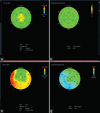Echocardiography in Athletes in Primary Prevention of Sudden Death
- PMID: 32089993
- PMCID: PMC7011488
- DOI: 10.4103/jcecho.jcecho_26_19
Echocardiography in Athletes in Primary Prevention of Sudden Death
Abstract
Echocardiography is a noninvasive imaging technique useful to provide clinical data regarding physiological adaptations of athlete's heart. Echocardiographic characteristics may be helpful for the clinicians to identify structural cardiac disease, responsible of sudden death during sport activities. The application of echocardiography in preparticipation screening might be essential: it shows high sensitivity and specificity for identification of structural cardiac disease and it is the first-line imagining technique for primary prevention of SCD in athletes. Moreover, new echocardiographic techniques distinguish extreme sport cardiac remodeling from beginning state of cardiomyopathy, as hypertrophic or dilated cardiomyopathy and arrhythmogenic right ventricle dysplasia. The aim of this paper is to review the scientific literature and the clinical knowledge about athlete's heart and main structural heart disease and to describe the rule of echocardiography in primary prevention of SCD in athletes.
Keywords: Athlete's heart; cardiomyopathy; echocardiography; myocardial work; prevention; speckle tracking strain; sudden cardiac death.
Copyright: © 2020 Journal of Cardiovascular Echography.
Conflict of interest statement
There are no conflicts of interest.
Figures






References
-
- Priori SG, Blomström-Lundqvist C, Mazzanti A, Blom N, Borggrefe M, Camm J, et al. 2015 ESC guidelines for the management of patients with ventricular arrhythmias and the prevention of sudden cardiac death: The task force for the management of patients with ventricular arrhythmias and the prevention of sudden cardiac death of the European society of cardiology (ESC). Endorsed by: Association for European paediatric and congenital cardiology (AEPC) Eur Heart J. 2015;36:2793–867. - PubMed
-
- Mendis SP, Norrving B. Geneva: World Health Organization; 2011. Global Atlas on Cardiovascular Disease Prevention and Control.
-
- Kim JH, Malhotra R, Chiampas G, d’Hemecourt P, Troyanos C, Cianca J, et al. Cardiac arrest during long-distance running races. N Engl J Med. 2012;366:130–40. - PubMed
-
- Corrado D, Pelliccia A, Bjørnstad HH, Vanhees L, Biffi A, Borjesson M, et al. Cardiovascular pre-participation screening of young competitive athletes for prevention of sudden death: Proposal for a common European protocol. Consensus statement of the study group of sport cardiology of the working group of cardiac rehabilitation and exercise physiology and the working group of myocardial and pericardial diseases of the European society of cardiology. Eur Heart J. 2005;26:516–24. - PubMed
